You are reading the older HTML site
Positive Feedback ISSUE
19
may/june 2005
June 2005 - Here are some hi-res excerpts from our June Issue
Competing MAHLER Symphony No. 9s - Concertgeouw/Riccardo Chailly (Decca); San Francisco Sym./Michael Tilson Thomas (SF Sym.)
Both 2-disc SACDs, both superb, both make good use of surround sound
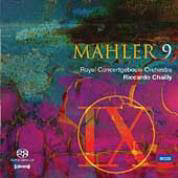
MAHLER: Symphony No. 9 - Royal Concertgebouw Orchestra/Riccardo Chailly - Decca multichannel SACD (2 discs) 4756191, 89:56 ****:

MAHLER: Symphony No. 9 - San Francisco Symphony/Michael Tilson Thomas - San Francisco Symphony multichannel SACD (2 discs) 821936-0007-2, 89:27 *****:
If you don't want to read the rest of this just look at the number of stars above, but you really can't go wrong with either Ninth. They are actually rather similar in performance style and sonics. Both conductors bring out clean details in the dense score without missing out on the grand overall scheme. They are both successful at maintaining the slow tempi often called for without bogging down overmuch in the painful confrontation with mortality which is a Mahler characteristic, but more so in the Ninth than any other of his symphonies.
Going to a strictly instrumental symphony after the hodgepodge of the vocal-choral-instrumental Eighth (though a successful hodgepodge), Mahler must have had in mind the final symphonic statements of several preceding composers. But at the same time He was already planning his Tenth, which he failed to live to complete. The half-hour-long initial movement is a symphony in itself and has been described by one authority as "an exhausting depiction of catastrophe." Mahler had never before strung out his special ability to create a new world of sound out of a few themes as he did in this first movement of the Ninth. He follows it with "something completely different," as the Pythons would say. The sequence of waltzes and ländlers, which alternate between the charming and heavy-footed parody, are almost a cousin in intent to Ravel's later La Valse. The third movement Rondo-Burleske would normally be a light-hearted and melodic respite from the doom and gloom, but Mahler crams it with obsessive recurring counterpoint that may show his veneration of J.S. Bach but is closer to a Bachian nightmare. The closing, nearly half-hour-length Adagio takes a lovely theme through an endless series of imaginative variations. The elegiac mood of the movement seems to represent an acceptance of and resignation to death.
Chailly has been committing to disc the nine Mahler symphonies over a 15-year period and this is the last. In the first decade of the 20th century Mahler himself conducted his music in Amsterdam. I envision the composer would be reduced to tears if he could hear the extent to which both of these new surround sound recordings immerse a listener (although second-hand) in his epic symphonic journey. The surround channels on both do a good job of recreating the feeling of being in the concert hall. With its reputation as perhaps the world's best concert hall, one would think the Concertgebouw recording would win hands down, but I would say it's a draw. Perhaps I'm prejudiced by being completely familiar with SF's Davies Hall but never have heard a concert in the Concertgebouw. [With most symphonic SACDs having only the hall reverberation on the surround channels, it is vitally important to have a properly-adjusted balance between them and the frontal channels—even to changing the levels depending on the particular recording. Some multichannel SACDs have such a subtle signal on the surrounds that one wonders if it isn't just an artificial L-R and/or reverb effect created from the front channels. I discovered that I had the rear-facing tweeters on my surround Von Schwiekert VR-2s turned down too far. Raising their levels created a considerably more realistic surround field as there is as much space in the room behind them as in front of them.]
The Concertgebouw string section is a bit richer sounding than the San Francisco forces, but I found that Tilson Thomas points up more of the angst and obsessive-ness in Mahler's music. His accent on the dramatic echoes the approach of his former mentor Leonard Bernstein but never goes over the top as did Bernstein occasionally. The SF recording was also made live during a public performance and I couldn't find any indication that the same was true of the Chailly recording. This fact may have aided the added excitement generated by the MTT version. But, regardless, the release of two competing multichannel recordings of such high quality in both performance and sound demonstrates that the promise of the SACD format is being delivered without compromise.

Live at the Keystone with Merl Saunders, Jerry Garcia etc. A traditional rock jam of mostly originals a la The Allman Bros.
Merl Saunders/Jerry Garcia/John Kahn/Bill Vitt - Live At Keystone, Vol. 1; Fantasy FSA-7701-6 Hybrid Stereo SACD ***1/2:
This disc slides right into a funky guitar riff with psychedelic keyboards and backing instrumentation. This is the first of the "jam session" recordings between Saunders and Garcia. Saunders has worked with varied artists like Bonnie Raitt, Harry Belafonte, and Frank Sinatra, but his most prolific association was with Garcia leading to several records. The vibe on this disc is mellow and smooth as is the recording. The concert was recorded live at Keystone in Berkeley, July 1973. A few of the songs are covers, but most of the material is original. The record is heavy on groove and style—it's very 70s. "It's No Use" is a blues tune, that, like the other music on this disc is not too gritty or hard-hitting, but manages to sneak up on you in a good way. The last track is a bonus track that runs for 13 ? minutes. It's a more traditional rock jam ala the Allman Brothers or John Mayall. It's a nice addition to the record and pushes the running time of the disc close to an hour. If you're a fan of Jerry Garcia, or 70s groove rock then this record is for you.
Songs included are: Keepers, Positively 4th Street; The Harder They Come; It Takes A Lot To Laugh, It Takes A Train To Cry; Space; It's No Use; Merl's Tune (bonus track). Brian Bloom
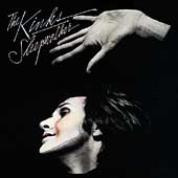
The Kinks - Sleepwalker, one of 15 Kinks klassics remastered in SACD by Koch
The Kinks - Sleepwalker; Koch Records VEL-SC-29810 Hybrid Stereo SACD ***1/2:
This is another one of 15 Kinks' records that have been remastered and distributed in the SACD format. They are hybrid discs, so you can enjoy them on any CD player. Right at the time that the Kinks had signed up with Arista Records in 1976, Ray Davies had began a change in writing style towards concept records. The record company was expecting the band to produce records in the glam rock style that had become popular and led them to sign people like Lou Reed and David Bowie. Needless to say, Arista was unhappy with the change and relations were strained. By the time this record came out in 1977, Davies and swung back to a more conventional rock format, although the songs still tell stories and work under the theme of a somnambulist.
One of the differences that had an impact on the production and sound of this record (versus the material before) was the fact that the band began recording in their own studio. This enabled them to take control of the entire process and craft the songs as exactly as desired. The record is a mix of semi-hard rock tunes and slower, melodic tunes with the infamous Kinks' sound—the vocals are unmistakable. The disc insert, written by John Swenson, takes the listener track by track and expands upon the meaning of the songs with all sorts of background information. The bonus tracks are this record are a real treat and will make this album worthy of purchase for any Kinks fan. "Prince of The Punks" is a poke at the pseudo punk rockers at the time of writing (who Davies apparently has quite distaste for). "The Poseur" is a great tune with odd, almost macabre-sounding background music.
Recording quality is good, although it doesn't come close to a newer, high quality recording in terms of transparency. It does lack harshness and irritation even if it lacks the utmost in fidelity, so it's an easy listen. I preferred the latter recording of "On The Outside" in terms of sense of space and involvement. Songs included are: Life On The Road; Mr. Big Man; Sleepwalker; Brother; Juke Box Music; Sleepless Night; Stormy Sky; Full Moon; Life Goes On. Bonus Tracks: Artificial Light; Prince Of The Punks; The Poseur; On The Outside (1977 Mix); On The Outside (1994 Mix). Brian Bloom
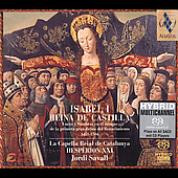
Isabel I, Queen of Castilla - Jordi Savall directs Catalan musical masterpieces of the 15th century
VARIOUS COMPOSERS: Isabel I, Reina De Castilla - Members of Hesperion XXI/Jordi Savall, director, viol/Montserrat Figueras, mezzo-soprano/Arianna Savall, soprano. Alia Vox Multichannel SACD AVSA9838 *****:
There is not much you can fault any CD Jordi Savall produces or plays in. The man is not only a genius at coaxing melancholic tones from the viol, he is also the most creative of musical programmers. In this one he manages to find Catalan musical pieces, both vocal and instrumental, from key years during the reign of Queen Isabel I of Spain (1451-1504). The music is an entrancing mixture of west European sacred/secular polyphony, Sephardic ballads, and dance pieces with obvious Moorish influence. In what must be the most propitious musical marriage of modern times, the astounding Montserrat Figueras performs with her husband Savall in haunting pieces like Triana, which sounds like a love ballad but is about the Immaculate Conception. His daughter Arianna sings on this piece too, and sings well, but not with the same weathered style as her mother. Most of the vocal works are translated except the most beautiful one: Cancion en ritmo Quddan de la Nuba Gribt Al Hussein de Marruecos. Sung in what appears to be Arabic, it could be about anything. (Was this the annotator's oversight or couldn't they find a translator?) Buy this attractively packaged, well engineered, splendidly performed disc. The SACD sound is rotund and opulent, particularly in the polyphonic choral interludes. You can't go wrong. Peter Bates
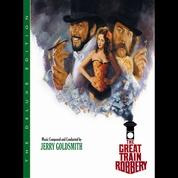
Jerry Goldsmith's score for the film The Great Train Robbery, Music from the l979 feature on multichannel SACD
JERRY GOLDSMITH: The Great Train Robbery - Music from the Film conducted by Jerry Goldsmith - Varese Sarabande Multichannel SACD 302 066 55 2 ****:
This and a companion SACD, Timeline, have probably been issued in connection with the recent passing of the eminent film composer. But it can only be a positive thing to have more of his high quality scores available and in hi-res surround sound to beat. The film, with Sean Connery and Donald Sutherland, came out in l979 and concerned what was at the time called "The Crime of the Century" - the theft in 1855 London of 12,000 Pounds in gold bullion from a train.
Goldsmith fashioned a breathtaking opening theme for the film which promises a bloody good time to come both music-wise and with screen action. Harp and harpsichord are often heard in the score, which cues are described in detail in the note booklet, connecting them with the progress of the film. The orchestra has a rich and glorious sound which equals the best of the new-recorded symphonic versions of the scores from past films. But it is actually the original material heard with the film. The complete set of 24-track master tapes was discovered and remixed at the Todd-AO Scoring Stage for multichannel SACD.
Cues: Main title, Breakfast in Bed, No Respectable Gentleman, Clues, Rotten Row, The First Key /Bordello Raid, Kiddie Kaper, Street Attack /Casing the Station, Over the Wall, Night Entry, Double Wax Job, The Tombstone, Departure, The Gold Arrives, Torn Coat, End Title. John Sunier

Jerry Goldsmith: Timeline - Music Inspired by the Film. The studio-rejected score - Hollywood Studio Symphony cond. by composer
JERRY GOLDSMITH: Timeline - Music Inspired By the Film - Hollywood Studio Symphony/Goldsmith - Varese Sarabande Multichannel SACD 302 066 600 2 ****:
The reason for the subtitle above is that after test screenings of the film using Goldsmith's sumptuous original score, the studio decided to the opening scene of the film and to replace Goldsmith's entire score with one by Brian Tyler which they felt would sell better with audiences. (It didn't do any good, the film was still a loser.) Not wanting to let another rejected score for a film—as did Alex North's original score for 2001 and several others—get lost, Goldsmith and Varese got together and here is his original score on an SACD release.
There is no synopsis of the film and I don't recall seeing a review of it, so I can only surmise this is a medieval adventure which somehow involves some time travel. The book is by Michael Crichton, who also was the source of the other Goldsmith soundtrack released on SACD at the same time—The Great Train Robbery. This score is not as much fun as that one, but is certainly a magnificent Goldsmith effort. There are some hints of ancient modes and polyphony but this is in general a late-Romantic orchestral score continuing and updating the tradition first established in Hollywood by Erich Korngold. The surround sound mix is effective without completely surrounding the listener with instruments.
Cues: The Dig, Cornflakes, No Pain, To Castlegard, Find Marek, The Rooftop, A Hole in the Wall, Move On, Be Careful, Ambushed, Setting Up, Greek Fire / Light the Arrows, Prepare for B
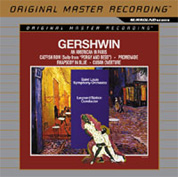
Gershwin works from the St. Louis Sym./Leonard Slatkin classic set now in SACD - An American in Paris, Catfish Row Suite, Rhapsody in Blue, Cuban Overture, Promenade
GERSHWIN: An American in Paris; Catfish Row Suite (from Porgy & Bess); Rhapsody in Blue; Cuban Overture; Promenade - St. Louis Symphony Orchestra/Leonard Slatkin cond./Jeffrey Siegel, piano - Vox/Mobile Fidelity Multichannel SACD, MFSL UDSACD 4007 ****:
This is about half of the highly-regarded Gershwin set recorded in St. Louis back in 1975 by the team of Abort & Nickrenz. The entire set was issued on two 96K DAAD discs by Classic Records some years ago—among the best of that format ever issued, and the comparable selections sound very similar except for the feeling of the concert hall added in Mo-Fi's excellent multichannel version. When a major climax is followed by silence, the two-channel version has the hall reverb die oujt quickly and all in front, whereas on the multichannel it is all around you and even a subtle vertical dimension. (The DAAD set also included Gershwin's exciting Piano Concerto in F, the Second Rhapsody, and the Variations on I Got Rhythm.) The originals were recorded in four channel and were issued on Vox QS quadraphonic LPs. Mo-Fi has preserved the 4.0 channel setup as they did in their earlier reissues of Vox and Turnabout quad tapes.
The Catfish Row suite is an interesting instrumental version of music from Gershwin's unique opera Porgy and Bess. Some of the music is less well known; in fact the big hits such as Summertime are not even here. There are solos for piano and banjo. While the soundstage is primarily frontal, the warning bell for the coming hurricane on Kittiwah Island is heard very loudly on the surrounds. The Cuban Overture is just as wildly energetic a version as that of the Boston Pops on RCA, but with the added catnip of gangbuster Cuban percussion coming loudly out of the surround channels. These guys are drumming up a storm, warning bell or not. John Sunier
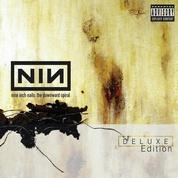
Nine Inch Nails - The Downward Spiral Deluxe Edition; Universal b0003739-36 Hybrid Multichannel SACD **** (see below):
The release of this 2-disc set coincides with the 10-year anniversary of the release of The Downward Spiral. To many fans of Trent Reznor, this record has become a classic and aside from a few "hit" songs that were played on the radio, there is a wealth of dark, brooding, disturbing material on these discs. From the start, the best way to describe this record and the way it is has been remixed as an audio assault rather than strictly a multi-channel music experience. Every channel pelts the listener with sound creating a sense of being confined and closed-in complete with hard grinding sounds, sounds of being beaten and/or tortured, and general sounds of terror. The effects on "Closer" and "Mr. Self Destruct" are almost uncomfortable on a good system played at a loud volume—and I'd like to think that this is the intended effect. Reznor is as angry and degraded as ever on this record, but like the previous EP, Closer, you can hear the progression from the more conventional Pretty Hate Machine to this record. Most fans would say that there will never be another like The Downward Spiral and they may be right.
There will be those who will listen to 10 seconds of this album and proclaim it "noise." The rating above is not directed at this group. There is so much going on here musically, that like many artists in their day who were a bit ahead of their time, it is really worth a further listen. No doubt many listeners and artists will be influenced by the style and sounds created throughout this record. Perhaps the music is an exercise in depravity, degradation, or depression, but the ability to convey this emotion is where the record succeeds. The songs where melodic music provides the backdrop are not only more listenable, but even more convincing in their ability to blend the message and the medium of delivery. Is Reznor the torturer or the tortured? While "Closer" (the big radio hit) pumps away there is no escape from ideas like "[violent sex] will bring [one] closer to God." "Hurt" is an example of a slower tune that hints at vulnerability, yet it's twisted too as Trent admits that "[he] will make you hurt."
The insert offers lyrics to material on both discs. Unfortunately, the second disc is not in surround. The quality is still very good, but it doesn't have the same impact as the original material. Many of the tracks are available on EPs or soundtracks, so true fans may already have the material. "Closer (Precursor)" is a cool, slow version that sounds like music from the movie Se7en. There are some stripped-down versions that focus more on individual sounds in the mix rather than the integrated cacophony of the originals. This makes them interesting, but overall, less satisfying. The "Ruiner (demo)" is a worthy addition to the list of tracks—it has such a weird feel to it that it is hard to describe. A lot of the other tracks are just filler. Whether you find this a work of art or music not worthy of your time is dependent on your taste in music. I wouldn't recommend heavy metal to a staunch classical listener, nor would a bubble-gum pop listener be inclined to listen to classic blues. If you are interested in some new trends in the alternative genre or are looking for a different experience, then check out this record---especially the multichannel version!
Songs included are: Disc 1 (Multichannel): Mr. Self Destruct; Piggy; Heresy; March of the Pigs; Closer; Ruiner; The Becoming; I Do Not Want This; Big Man With A Gun; A Warm Place; Eraser; Reptile; The Downward Spiral; Hurt. Disc 2 (remixes, b-sides, non-album tracks—Stereo): Burn; Closer (Precursor); Piggy (Nothing Can Stop Me Now); A Violent Fluid; Dead Souls; Hurt (Quiet); Closer To God; All The Pigs, All Lined Up; Memorabilia; The Downward Spiral (The Bottom); Ruiner (demo); Liar (Reptile demo); Heresy (demo). Brian Bloom
Reviews reprinted with permission from Audiophile Audition

